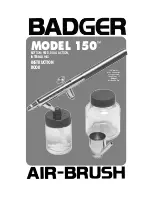
3
fine line or small dot is achieved by working very close to the surface while releasing a very small
amount of paint. A broad spray pattern is achieved by moving the airbrush back from the work surface
and pulling back further on the trigger to release a larger amount of paint. The proper mechanics for
triggering the airbrush are – press down to start air flow, pull pack to begin and increase paint flow,
push forward to lessen or stop paint flow, release (or up) to stop air flow.
LEARN TO TRIGGER
Best results are achieved with the Model 150
™
by airbrushing with a good constant motion. Start motion
before pressing trigger, follow through motion after releasing trigger. Do not hesitate while spraying or you
will create what is called the Barbell Effect.
MAINTENANCE AND CLEANING OF YOUR AIRBRUSH
Careful cleaning and maintenance of your airbrush is essential if it is to continue to work effectively. The
small passages inside the airbrush can become blocked easily by dried paint if the airbrush is not cleaned
after each use. If there is still a useable amount of color in the color cup or reservoir when you have fin-
ished spraying, pour the remainder back into the original paint bottle. Operate the airbrush, spraying on a
scrap piece of paper until the color is gone and only air is sprayed. Take a clean color cup or jar full of
appropriate cleaner. Insert it into the airbrush, spray some cleaner through the airbrush at broad and small
patterns until it comes out colorless. After removing color cup or jar, carefully remove needle and clean off
any paint residue off needle. Before inserting needle into airbrush apply Regdab (airbrush lubricant #122)
the the front of needle. Unscrew and clean internal area of regulator (50-0372) then reinstall. Always clean
the airbrush every time you finish spraying as some types of paint can dry remarkably fast, and may cause
your airbrush to clog if not cleaned properly.
Another method of cleaning the airbrush is back flushing using a closed container such as a jar assembly.
Take a soft cloth and cover the spray regulator – depress and pull back on the trigger. This will cause back
pressure which induces a bubble action inside the airbrush and in the container which helps to clean the fluid
passages. Never use an open color cup for this procedure as color will blow out. Take away the cloth and
spray and repeat this procedure several times. After this is done you should remove the needle for cleaning.
If the paint is allowed to dry inside the airbrush you may not be able to dissolve it with clean water.
Cleaning with solvent is the next step. If cleaning with solvent does not dissolve the blockage, you will
have to disassemble the airbrush, by first removing the needle and then the head. Soak the tip in warm
soapy water or appropriate solvent for ten minutes. Then take a tooth pick and gently remove the dried paint
from inside the fluid tip. This procedure may have to be repeated. Be careful during disassembly not to lose
any small parts. NOTE: Periodically the head seal (50-055) will need to be replaced, as repetitive
disassembly may cause the head seal to leak air creating a pulsating effect. If only water based paints are
used, a head seal (51-099) will last an extended period of time.
Replacing the Tip
Begin by removing head (50-038) from the body of the brush. Place 3-cornered reamer (50-061) through
center post of head as you would position the needle. Grasping head, turn reamer counter-clockwise to
remove damaged tip. Place new tip on pointed end of reamer. Place a small amount of beeswax (50-050)
to threads of tip. Hold tip in place with index finger while gently pushing head up to meet tip. Slowly turn
head counter-clockwise until tip is seated firmly in head and there is no visible gap between head and tip.
With a lighted match melt wax while turning head so as to seal the joint. After wax has hardened
(approximately 10 seconds), gently remove excess with fingertips. Remove 3-cornered reamer. Return
head to body of brush.
SURFACE
START
PRESS
PULL
KEEP STEADY
MOVE
RELEASE
FOLLOW
MOTION
TRIGGER
TRIGGER
MOTION
TRIGGER
TRIGGER
THRU
HERE
DOWN
BACK
AND SPRAY
FORWARD
MOTION
DON’T ARC
If airbrush motion in uneven,
paint finish will be uneven.
SURFACE
BUILD-UP
ARCING MOTION
THE MOST COMMON PROBLEM
Runs and sags are caused by one or more of the
following errors.
1. “Freezing” or forgetting to release trigger at the
end of the stroke.
2. Holding airbrush still or moving too slowly.
3. Holding airbrush too close to surface.








